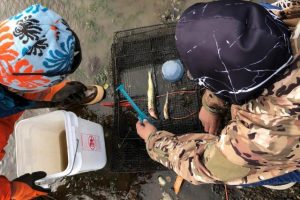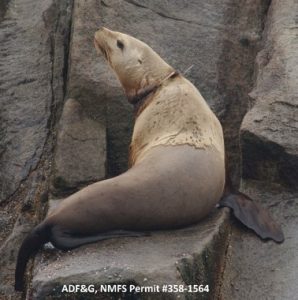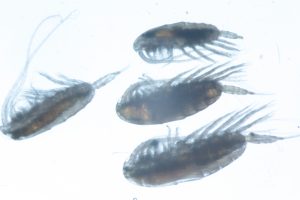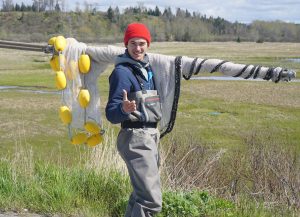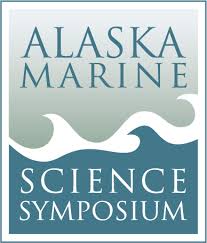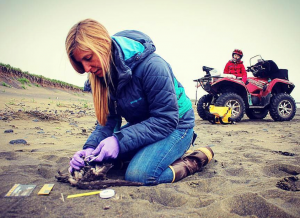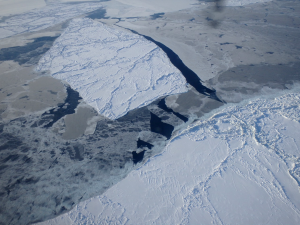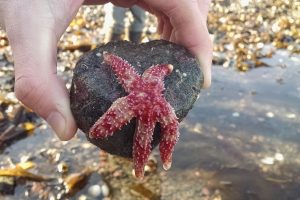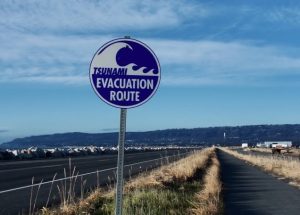Hitching a Ride: How to Spot and Stop Marine Invasive Species
Jasmine Maurer from NOAA’s Kachemak Bay National Estuarine Research Reserve in Kachemak Bay, AK How do invasive and exotic marine species arrive and spread in Alaska? We will talk about how to monitor and identify European green crab and tunicates, how they affect ecosystems, and what actions to take before the summer season to…
Read MoreLose the loop: How did entangled Steller sea lions lead to Alaska’s first Ocean Guardian schools?
Kim Raum-Suryan, NOAA Fisheries’ Alaska Region in Juneau, AK Join us as we learn about how marine debris impacts Steller sea lions, how we disentangle Steller sea lions, and how this helped us bring NOAA’s Ocean Guardian School Program to Alaska. Explore more about the Ocean Guardian School Program, how you can get this program…
Read MoreLet it Snow, Let it Snow, Let it Snow…but How Much?
Dr. Jessica Cherry, NOAA’s National Weather Service’s Alaska-Pacific River Forecast Center in Anchorage, AK Snow is a critical part of the annual water cycle throughout Alaska and provides important ecosystem services to plants and animals (including humans). Join us to look at how snow interacts with the environment in different parts of our state and…
Read MoreLet’s Talk about Fish Food: Zooplankton in the Eastern Bering Sea
Deana Crouser, NOAA Fisheries Alaska Fisheries Science Center in Seattle, AK What do you think fish eat in the ocean? A lot of fish eat zooplankton in the Bering Sea. Join us to find out how zooplankton response to climate change can affect what fish are available for us to eat! Resources to access at…
Read MoreSalmon in the Winter: Anadromous fish under ice
Coowe Walker and Jacob Argueta, NOAA’s Kachemak Bay National Estuarine Research Reserve in Kachemak Bay, AK What do you know about baby salmon? Join us to learn about where salmon spend their early life stages, and how they survive in watersheds blanketed with snow and ice. We will talk about the importance of groundwater on…
Read MoreAlaska Marine Science Symposium in Anchorage: Cutting-Edge Science Connecting with Education
Elizabeth Siddon, NOAA Fisheries Alaska Fisheries Science Center in Juneau, AK, and Mark Van Arsdale, Eagle River High School in Eagle River, AK Every January in Anchorage, scientists, educators, resource managers, students, and the public come together at the Alaska Marine Science Symposium (AMSS) conference to discuss the latest marine research being conducted in Alaska…
Read MoreYouth Programs on St. Paul Island, Alaska
Lauren Divine and Veronica Padula, Aleut Community of St. Paul Island Tribal Government on St. Paul Island, AK In the middle of the Bering Sea, between Russia and North America, is the Alaskan island of St. Paul – an incredible place with an amazing community and some of the coolest wildlife in the world. There…
Read MoreAlaska Sea Ice, Ice, Baby
Michael Lawson, NOAA’s National Weather Service in Anchorage, AK Learn all about Alaska sea ice from a National Weather Service sea ice analyst! Come join us to find out about different types of sea ice, how it forms and is different than freshwater ice, and how NOAA sea ice analysts analyze sea ice from satellite…
Read MoreWhat’s in the Kelp Forest? Exploring the Shore and Diving Underwater in Kachemak Bay, Alaska
Kris Holderied, NOAA Kasitsna Bay Laboratory, NOAA Ocean Service and Katie Gavenus, Center for Alaskan Coastal Studies Come find out about the unique ecology and research in Kachemak Bay, Alaska! Kachemak Bay is home to a wide variety of animals — sea stars, nudibranchs, anemones, clams and snails, octopus, crabs, all sorts of fish, and…
Read MoreNot Your Friendly Neighborhood Wave: Staying Safe from Tsunamis in Alaska
Dr. Summer Ohlendorf, NOAA’s National Weather Service Tsunami Warning Center in Palmer, AK Earthquakes, volcanoes, landslides, oh my! What’s one thing these hazards have in common? They’re all capable of moving a large amount of water very quickly, creating a special set of waves called a tsunami. While the most well known tsunami up here…
Read More
